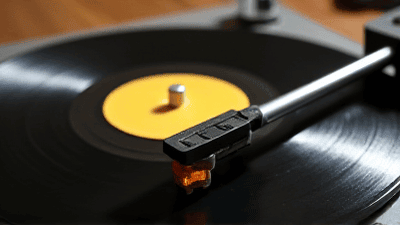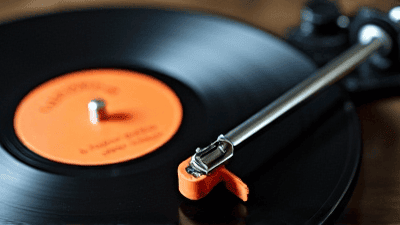
The Enduring Groove: Why Vinyl Records Are Thriving in a Stream-Dominated World
The resurgence of vinyl records stands as one of the most intriguing paradoxes of the digital age. In an era where music is overwhelmingly consumed via instant, lossy streaming platforms, the tangible, often cumbersome, and more expensive vinyl format continues to shatter sales records. This phenomenon challenges conventional wisdom about convenience and technological progress, signaling a deeper cultural shift where the value of a physical, experiential object transcends mere audio delivery.
This unexpected comeback is not just a niche fad; it represents a significant recalibration of consumer priorities within the global music industry. Vinyl's renewed prominence impacts artists seeking alternative revenue streams, engages audiophiles pursuing sonic fidelity, and captivates new generations discovering the ritualistic appeal of physical media. Industry reports highlight consistent year-on-year growth for vinyl, even as CD sales decline further, sparking debates about the inherent value of ownership versus access. Understanding this revival is crucial for record labels, music retailers, and even technology developers. What impact would it have on our understanding or practice of music consumption if we failed to fully comprehend the powerful blend of nostalgia, aesthetics, and auditory experience driving vinyl's remarkable return?
The Irresistible Allure of Analog

Beyond Sound: The Sensory and Ritualistic Experience
The primary draw of vinyl records extends far beyond their auditory output; it encompasses a holistic sensory and ritualistic experience largely absent in digital formats. When a record is carefully removed from its sleeve, placed on a turntable, and the needle gently lowered, it initiates a deliberate act of engagement. This process, often referred to as "the ritual," fosters a deeper connection between listener and music, contrasting sharply with the passive, often background, nature of streaming. The "warmth" attributed to analog sound, while partly subjective, stems from its continuous waveform, which avoids the discrete sampling inherent in digital audio. This subtle sonic character, often described as richer or more natural, is perceived by many as a more authentic representation of the original recording. For instance, audiophiles often highlight how vinyl can better convey the natural decay of an instrument's sound or the spatial separation of a live performance. This physical interaction transforms listening into an active pursuit, a cherished moment of focused appreciation. The tactile feel of the grooves, the weight of the record, and the anticipation built during playback contribute to a profound sense of presence, anchoring the music experience in the physical world.
Echoes of the Past, Shaping the Future
Cultural Resonance, Collectibility, and Market Dynamics
Vinyl's resurgence is deeply intertwined with its potent cultural resonance, particularly its appeal to nostalgia and its intrinsic collectibility. For older generations, records evoke cherished memories of youth, forming a tangible link to personal history and beloved artists. For younger generations, vinyl represents a discovery of a "cooler," more authentic way to engage with music, a rebellion against the ephemeral nature of digital files. This perceived authenticity is a key driver. Furthermore, vinyl records are inherently collectible items, offering unique artwork, liner notes, and limited editions that foster a passionate community of collectors. This aspect transforms music consumption into an act of curation and investment. Artists, both established and independent, increasingly embrace vinyl as a premium product, offering fans a more substantial way to support their work and own a piece of their artistry. This dynamic has revitalized independent record stores, transforming them into cultural hubs.
The market statistics emphatically illustrate this trend. After decades of decline, vinyl album sales have seen extraordinary growth, outpacing digital downloads and even CDs in recent years. This growth is a global phenomenon, underscoring its broad appeal.
| Year | Vinyl Album Sales (Millions USD) | Percentage Change from Prior Year | Share of Physical Album Sales |
|---|---|---|---|
| 2019 | 504 | +14.5% | 15.6% |
| 2020 | 626 | +24.2% | 18.9% |
| 2021 | 1,042 | +66.5% | 29.8% |
| 2022 | 1,223 | +17.4% | 34.6% |
| 2023 | 1,387 | +13.4% | 38.3% |
Data based on RIAA reports for the U.S. market, representing wholesale value.
This table highlights a consistent and significant upward trajectory in vinyl sales, demonstrating its increasing market share within physical media. The substantial percentage changes, especially in the post-pandemic years, underscore vinyl's robust performance. This market growth signals that vinyl is not just a fleeting trend but a solidified segment of the music industry, driven by dedicated consumer demand that values ownership, quality, and the overall experience over sheer convenience. The economic value extends to related industries like turntable manufacturing and record cleaning supplies, creating an entire ecosystem around the format.
Marrying Old and New: Vinyl in the Digital Ecosystem

Modern Production, Distribution, and Hybrid Listening Experiences
The resurgence of vinyl isn't solely a nostalgic throwback; it's also a testament to modern technological advancements and distribution methods that have made the format more accessible and higher quality than ever before. Contemporary pressing plants utilize precision machinery and improved quality control, reducing common issues like warps and surface noise that plagued older records. Mastering engineers now often create dedicated masters for vinyl, optimizing the sound specifically for the analog format to achieve superior fidelity. Furthermore, the internet has played a pivotal role in distribution, allowing independent labels and artists to reach a global audience directly through online stores, crowdfunding platforms, and social media. This bypasses traditional gatekeepers and fosters niche communities.
Vinyl records and digital streaming are not mutually exclusive; rather, they often coexist in a "hybrid listening" model. Many consumers stream music for discovery and convenience while purchasing vinyl for their favorite albums as a mark of appreciation and for dedicated listening sessions. Services like Bandcamp, for instance, facilitate digital downloads alongside vinyl purchases, creating a seamless experience. This integration shows that vinyl isn't rejecting the digital age but rather complementing it, offering a deeper, more committed engagement for moments when high-quality, tactile interaction is desired. The modern vinyl consumer often appreciates both the boundless catalog of streaming and the tangible permanence of a physical record.
Conclusion
The remarkable resurgence of vinyl records in a predominantly digital landscape is more than a fleeting trend; it is a profound cultural statement and a significant market phenomenon. This article has explored the multifaceted reasons behind its comeback, emphasizing the unparalleled sensory and ritualistic experience that distinguishes it from purely digital consumption. We’ve delved into its potent cultural resonance, driven by nostalgia, collectibility, and a desire for authentic engagement, which in turn has profoundly shaped market dynamics, as evidenced by consistent year-on-year growth and an expanding ecosystem. Finally, we examined how modern production techniques and digital distribution platforms have integrated vinyl into a hybrid listening environment, demonstrating its symbiotic relationship with, rather than outright opposition to, digital convenience. Vinyl's enduring appeal underscores a fundamental human desire for tangible connection, curated experiences, and a deeper appreciation of art in an increasingly ephemeral world. It reaffirms that value is not solely defined by speed or cost, but also by meaning, ritual, and sensory richness.
Looking ahead, the vinyl industry faces exciting prospects alongside evolving challenges. Continued innovation in pressing technologies, potentially addressing environmental concerns through more sustainable materials and production processes, could further solidify its market position. The ongoing integration with digital platforms, perhaps offering enhanced digital content with vinyl purchases, could foster even stronger hybrid consumption models. However, challenges persist, including managing increased demand for pressing plant capacity, addressing rising material costs, and ensuring consistent quality control across a rapidly expanding market. The macro scientific trend towards personalized, immersive experiences could further benefit vinyl, positioning it as a premium, mindful listening choice. Continued research into listener psychology and the neuroaesthetics of music will be vital to understand the enduring connection between humans and physical sound carriers. The vinyl revival serves as a potent reminder that in a technologically advanced world, the value of the tangible, the ritualistic, and the emotionally resonant will always find its audience, urging continuous exploration of how technology can enhance, rather than replace, deeply human experiences.
Frequently Asked Questions (FAQ)

Q: Is vinyl truly superior in sound quality compared to digital streaming or CDs? A: The question of vinyl's sound superiority is complex and often subjective, sparking considerable debate among audiophiles and general listeners alike. Technically speaking, digital audio formats (like CDs or high-resolution streaming) can offer a wider dynamic range and a lower signal-to-noise ratio, meaning less background hiss or distortion. This is because digital formats capture sound as discrete data points, which can be incredibly precise. Vinyl, being an analog medium, is inherently subject to physical limitations, such as surface noise (pops and crackles), tracking errors, and a more limited frequency response at the extremes. However, the perceived "warmth" and "richness" of vinyl's sound often comes from the subtle harmonic distortions and compression inherent in the analog process. These imperfections, far from being flaws, are what many listeners find appealing, contributing to a sound profile that feels more natural, "live," or less fatiguing. It's similar to how some prefer the subtle distortions of a tube amplifier over the clinical precision of a solid-state one. Furthermore, the quality of a vinyl playback system – including the turntable, cartridge, amplifier, and speakers – drastically affects the audio experience. A poorly mastered digital file will sound bad, just as a poorly pressed record played on cheap equipment will. Ultimately, while digital can achieve technically superior specifications, many argue that vinyl offers a more engaging and emotionally resonant listening experience, which is often more about the "feel" and presentation of the music than absolute sonic accuracy.
Q: Given its physical nature, isn't vinyl less environmentally friendly and less practical than digital music? A: The environmental footprint and practicality of vinyl records are indeed valid concerns when compared to the seemingly weightless and instantly accessible nature of digital music. From an environmental perspective, vinyl records are primarily made from polyvinyl chloride (PVC), a petroleum-derived plastic. The manufacturing process, transportation, and eventual disposal (or recycling, which is limited for PVC) contribute to a carbon footprint. However, it's crucial to consider the entire lifecycle of all music consumption methods. While digital streaming appears "green" on the surface, it relies on massive data centers, extensive server farms, and global internet infrastructure, all of which consume enormous amounts of energy. The continuous power consumption for streaming, device charging, and data transfer collectively have a significant environmental impact that is often underestimated. Studies comparing physical media to streaming sometimes show surprising results, depending on the assumptions made about electricity sources and data transfer efficiencies. On the practicality front, vinyl undeniably demands more effort: dedicated playback equipment, physical storage space, and careful handling to maintain condition. Digital music, in contrast, offers unparalleled convenience—instant access to millions of songs anywhere, anytime, on any device. Yet, for many vinyl enthusiasts, this "inconvenience" is precisely the point. The ritual of selecting, cleaning, and playing a record transforms music from a background commodity into a focal activity, a deliberate choice to engage more deeply with the art. The tangible nature of vinyl also offers a sense of permanence and ownership that digital files often lack, providing album art, liner notes, and a physical object that can be displayed and cherished. While digital offers broad access, vinyl offers deep engagement, making the perceived "impracticality" a feature, not a bug, for its dedicated audience.








